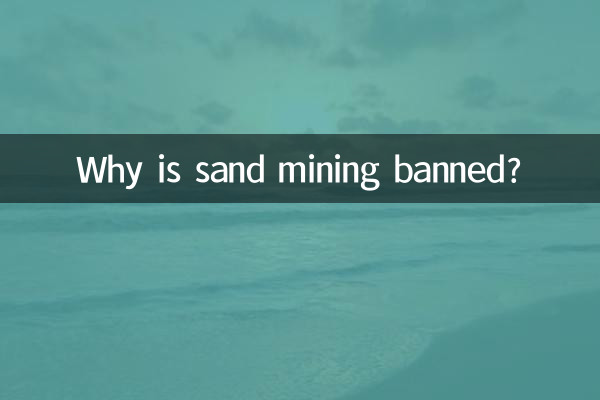Why is sand mining banned? ——The inevitable choice of ecological protection and sustainable development
In recent years, supervision of river sand mining has become increasingly strict around the world, and China has repeatedly issued bans to severely crack down on illegal sand mining. So why is sand mining banned? This article will analyze the deep reasons behind this policy from the perspectives of ecological damage, public safety, and economic impact, combined with hot topics in the past 10 days.
1. The dangers of sand mining: the grim reality revealed by data

Sand mining activities have many impacts on the natural environment and human society. The following is a quantitative analysis of the main hazards:
| Hazard type | Specific performance | Typical cases (last 10 days) |
|---|---|---|
| ecological damage | River channels are cut down, wetlands disappear, and water quality deteriorates | Illegal sand mining in a tributary of the Yangtze River reduced fish stocks by 30% |
| public safety | Dam collapse, bridge damage, coastal construction hazards | A small landslide occurred near a sand mining site after heavy rain. |
| economic loss | The cost of treatment far exceeds the benefits of sand mining | Illegal sand mining in a certain province caused direct losses of more than 500 million yuan in 2023 |
2. Policy basis for banning sand mining
The ban on sand mining in my country is not a one-size-fits-all policy, but a standardized management based on scientific assessment. Major laws and regulations include:
| laws and regulations | Main content | latest revision |
|---|---|---|
| "Water Law" | Clarify the river sand mining permit system | Revised 2021 |
| Mineral Resources Law | List sand and gravel as a protective mining mineral | 2023 Draft for Comments |
| "Yangtze River Protection Law" | Comprehensive ban on sand mining in the main stream of the Yangtze River | Implementation in 2021 |
3. Alternatives and Sustainable Development
While natural sand mining is banned, various localities are actively promoting environmentally friendly alternatives:
| alternative | Advantages | Application progress |
|---|---|---|
| Machine-made sand | Stable quality, capable of large-scale production | The annual production capacity of a certain province has reached 1 billion tons |
| Construction waste recycling | Realize resource recycling | The national recycled aggregate utilization rate reaches 40% |
| Sea sand desalination | Alleviating pressure on terrestrial resources | Processing centers have been established in many coastal provinces |
4. Analysis of recent hot events
In the past 10 days, hot events related to the sand mining ban have mainly focused on the following aspects:
1.Environmental Protection Inspectorate Notice: The Central Ecological and Environmental Protection Inspection Team discovered multiple cases of illegal sand mining in the name of dredging in a certain province, and the relevant responsible persons were severely dealt with.
2.Technological innovation: The "Electronic River Chief" system developed by a company uses satellite remote sensing to monitor changes in river courses in real time and has uncovered several cases of illegal mining at night.
3.international cooperation: Countries in the Mekong River Basin held a meeting to discuss a cross-border sand mining management collaboration mechanism, and China’s governance experience was recognized by many parties.
5. Future Outlook
With the further advancement of ecological civilization construction, the policy of banning sand mining will show three major trends:
1.Intelligent supervision technology: The proportion of technology applications such as drone inspections and big data analysis will increase to more than 80%.
2.Alternative industry scaling: It is expected that by 2025, the market share of manufactured sand will exceed that of natural sand.
3.Normalize public participation: Public supervision channels such as "shoot and report" will cover all counties and cities across the country.
The ban on sand mining may seem to limit short-term economic benefits, but in fact it is about protecting the source of life for future generations. Only by adhering to ecological priority and green development can we achieve harmonious coexistence between man and nature.

check the details

check the details